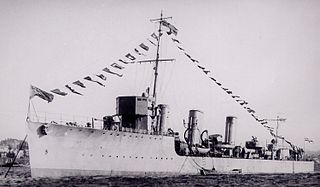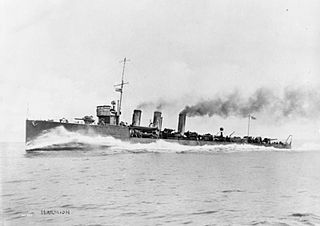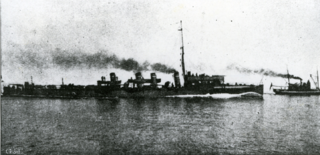Related Research Articles

The Havock class was a class of torpedo boat destroyer (TBD) of the British Royal Navy. The two ships, Havock and Hornet, built in London in 1893 by Yarrow & Company, were the first TBDs to be completed for the Royal Navy, although the equivalent pair from J.I. Thornycroft, Daring and Decoy, were ordered five days earlier.

Two Daring-class destroyers were the very first torpedo boat destroyers ("TBDs") to be ordered for the Royal Navy, the order being placed on 27 June 1892.
HMS Boxer was an Ardent-class destroyer which served with the Royal Navy, launched on 28 November 1894. She spent several years operating with the Mediterranean Fleet and remained active during the First World War. She was sunk in a collision on 8 February 1918.

HMS Bruizer was an Ardent-class destroyer which served with the Royal Navy. She was launched on 27 February 1895 by John Thornycroft at Chiswick, and was sold on 26 May 1914.
HMS Otter was a Vickers three-funnel, 30-knot destroyer ordered by the Royal Navy under the 1895–1896 Naval Estimates. She was the fourth ship to carry this name since it was introduced in 1782 for a fire ship, sold in 1801.
HMS Colne was a Thornycroft type River-class destroyer ordered by the Royal Navy under the 1903–1904 Naval Estimates. Named after the River Colne in eastern England, north east of London, she was the first ship to carry this name in the Royal Navy.

HMS Chelmer was a Thornycroft-type River-Class destroyer ordered by the Royal Navy under the 1903–1904 Naval Estimates. Named after the River Chelmer in eastern England, north-east of London, she was the first ship to carry this name in the Royal Navy.
HMS Jed was a Thornycroft type River-class destroyer ordered by the Royal Navy under the 1903 – 1904 Naval Estimates. Named after the River Jed in southern Scotland, she was the second ship to carry this name since it was introduced in 1814 for a 26-gun sixth rate ship sold in 1833.

HMS Desperate was a two funnel, 30-knot destroyer ordered by the Royal Navy under the 1894 – 1895 Naval Estimates. She was launched in 1896, served in Home waters and the Mediterranean before World War I. She was based in Portsmouth during the war and was sold for breaking in 1920.

HMS Fame was a two funnel, 30 knot destroyer of the Royal Navy, ordered under the 1894 – 1895 Naval Estimates. She was launched in 1896, served in Chinese waters for the whole of her life and was sold at Hong Kong in 1921.

HMS Foam was a two funnel, 30 knot destroyer ordered by the Royal Navy under the 1894 – 1895 Naval Estimates. She served in the Mediterranean for most of her short career and was sold in 1914, 4 months before the beginning of World War I.

HMS Cygnet was a two funnel, 30 knot destroyer ordered by the Royal Navy under the 1896 – 1897 Naval Estimates. She was the thirteenth ship to carry this name. She was launched in 1898, served in the Chatham division before World War I and was tendered to the gunnery school at Sheerness during the war. She was sold for breaking in 1920.

HMS Radiant was an R-class destroyer which fought in the First World War as part of the Royal Navy before being transferred to the Royal Thai Navy, in which she served until well after the Second World War.
HMS North Star was a Royal Navy Admiralty M-class destroyer constructed and then operational in the First World War. She was sunk in April 1918.

HMS Rosalind was an R-class destroyer which served with the Royal Navy. The ship was launched by Thornycroft on 14 October 1916 as the first of five similar ships ordered from the yard. The design was used as the basis for five subsequent ships of the S-class also built by the company. Rosalind served as part of the Grand Fleet during the First World War, operating as an escort to other warships and in anti-submarine patrols alongside other destroyers. The vessel was sold to be scrapped on 13 July 1926.
HMS TB 9 was a Cricket-class coastal destroyer or torpedo-boat of the British Royal Navy. TB 9 was built by the shipbuilder Thornycroft from 1905 to 1907. She was used for local patrol duties in the First World War and was sunk following a collision in the North Sea on 26 July 1916.

HMS Rapid was a destroyer of the M class which served with the Royal Navy. Launched by Thornycroft on 15 July 1916 as the first of six similar ships, the destroyer served as part of the Grand Fleet during World War I. The design was used as the basis for the subsequent five ships of the R-class also built by the yard. Rapid served in escort and patrol roles, principally providing defence from submarines as part of the Grand Fleet until it was disbanded at the end of the War. After the end of hostilities, the vessel served in minor roles, including briefly as part of the Admiralty Compass Department, but was sold to be scrapped on 20 April 1927.

HMS Nereus was a Admiralty M-class destroyer which served with the Royal Navy during the First World War. Launched on 24 February 1916, the vessel served with the Grand Fleet until the end of the conflict. The vessel operated as part for Thirteenth Destroyer Flotilla in support of convoy operations. After the conflict, the destroyer was worn out by the demands of high speed operation in poor weather. Nereus was placed in reserve and subsequently sold for scrap on 15 November 1921 after less than six years service.

HSwMS Magne was a torpedo boat destroyer of the Royal Swedish Navy. Magne was built by the British shipbuilder Thornycroft, launching in 1905. She was employed on neutrality patrol and escort duties during the First World War and was sold for scrap in 1943.
References
- ↑ Gardiner, Robert & Gray, Randal, eds. (1985). Conway's All The World's Fighting Ships 1906–1921. London: Conway Maritime Press. p. 76. ISBN 978-0-85177-245-5.
- ↑ Colledge, J. J.; Warlow, Ben (2006). Ships of the Royal Navy: a complete record of all fighting ships of the Royal Navy from the 15th century to the present. London: Chatham. p. 345. ISBN 978-1-85367-566-9.
- ↑ Friedman, Norman (2009). British Destroyers: From Earliest Days to the First World War. Barnsley: Seaforth Publishing. p. 211. ISBN 978-1-84832-049-9.
- ↑ Gardiner, Robert; Chesneau, Roger, eds. (1980). Conway's All The World's Fighting Ships 1922–1946. Conway Maritime Press. p. 346. ISBN 978-0-85177-146-5.